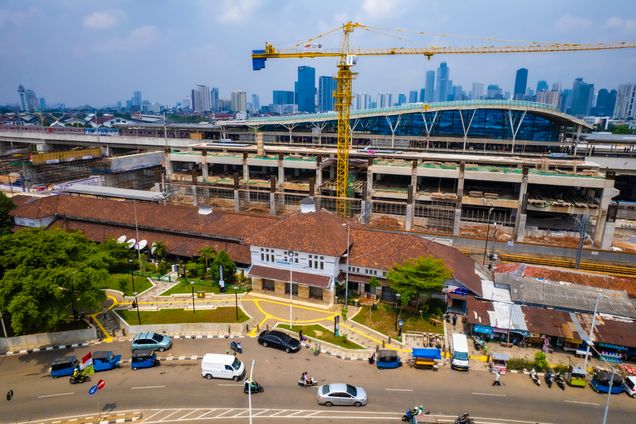Beyond Policy Banks: The Overseas Development Investment Funds Financing the Belt and Road Initiative

By Oyintarelado Moses and Laura Gormley
Through the ‘Going Out’ strategy and the Belt and Road Initiative (BRI), China has become the largest source of official bilateral development finance.
However, after reaching a peak in 2016, overseas development finance from China’s two main policy banks, the China Development Bank and the Export-Import Bank of China, has since waned. Amidst this trend, a diversification of finance beyond policy bank loans to foreign direct investment and other forms of finance is expected.
Since 2007, Chinese special investment funds targeting overseas development projects, termed overseas development investment funds (ODIFs), have emerged as a source of available capital. A new working paper from the Boston University Global Development Policy Center tracks, codifies and analyzes China’s ODIFs and assesses the potential role of ODIFs in China’s future overseas economic engagement.
The authors define ODIFs as pools of capital established by multiple public and/or private shareholders that primarily provide equity financing to certain regions and sectors overseas. ODIFs’ priorities expand beyond profit generation to include a focus on the developmental, socioeconomic impacts of projects and the creation of opportunities to strengthen economic relationships between China and host countries. This expanded mandate distinguishes ODIFs from profit-making commercial private equity funds. Although ODIFs are similar to development finance institutions (DFIs) because of their development mandates, they diverge in how they repatriate their profits and in their shareholder structures. ODIFs pay for temporary or partial ownership of a project with the goal of making profits upon exiting their investment–generally at a higher rate of return than loan interest rates. Investment returns are not used to replenish an ODIF’s pool of paid-in capital, as they would for a DFI, but instead are paid out directly to shareholders. Like commercial private equity funds, ODIFs are created by multiple shareholders from the public and private sectors, as well as other regions of the world.
Overall, China’s ODIFs present a total capitalization of $155 billion through 21 funds established between 2007-2019. This is not equivalent to disbursements, as ODIFs have only extended a portion of this finance for development projects. ODIFs’ shareholders span different public and private entities including policy banks, commercial banks, foreign exchange managers, corporations and foreign shareholders. ODIFs support many sectors including energy and resources (15 funds), general infrastructure (14 funds), manufacturing (11 funds), agriculture (nine funds), technology (eight funds), the financial sector (six funds), green development (four funds), the social sector (two funds), consumer goods and services (two funds) and capacity building (one fund). ODIFs may dedicate capital to certain regions including the Latin American and Caribbean region, which has the largest amount of dedicated capital at $42.2 billion, followed by Europe and Central Asia at $30.5 billion and Africa at $10 billion. About $70.3 billion in capital is available for projects globally.
The authors classify China’s ODIFs into three forms: sovereign development funds (SDFs), private equity funds (PEFs) and joint investment funds (JIFs). SDFs are investment funds wholly owned by state-owned entities that extend equity and debt for equity investments. The working paper identifies five SDFs with a total capitalization of $75.5 billion. The Silk Road Fund is the largest SDF, with a capitalization of $54.5 billion. PEFs are funds with a limited partnership structure and a limited fund life to hold and sell assets. These funds also provide equity and debt for equity instruments aimed at supporting overseas development. Seven PEFs were identified with a total of $45.3 billion in capitalization. JIFs are funds established by a Chinese and host country or regional institution for the purpose of extending equity and debt for equity instruments in development-related sectors in the host country or region. There are nine of these funds, with the overall smallest capitalization at $34.5 billion.
Given the novelty of China’s ODIFs and their available capital, these funds are poised to become more active sources of finance in China’s Belt and Road Initiative (BRI). Several recent policy directives from China indicate that a future increase in the use of ODIFs is likely. ODIFs have been mentioned in several Chinese policy documents such as the 2019 Belt and Road Forum List of Deliverables, the Forum on China-Africa Cooperation (FOCAC) Dakar Action Plan and the 2022 National Development and Reform Commission (NDRC) Green BRI guidelines. Mentioning ODIFs as future financing tools in these policy documents not only conveys their significance, but also signals how they could be better utilized in the coming years.
Dynamics in BRI countries may increase demand for financing from China’s ODIFs. As some Global South countries are currently managing debt distress or the risk of debt distress and considering alternative financing sources for domestic development, they will have to weigh the advantages and disadvantages of ODIFs.
The working paper contributes to a growing, empirically based understanding of the diversification of China’s overseas investment and development activity, channeled through equity and dedicated funds. ODIFs demonstrate a range of shareholders and fund structures across funds with similar goals of equity investment for overseas development. Further transparency is needed to understand the potential impacts of ODIFs, especially regarding disbursements. In addition, policy research is needed to understand the governance of ODIFs, especially at the project level.
As China’s overseas activity diversifies and China’s leaders promote the concept of a green BRI, a deeper understanding of ODIFs will be necessary to mitigate social, environmental and financial risks and maximize benefits of investment for development.
Read the Working Paper*
Laura Gormley is a Research Assistant with the Global China Initiative and an MA Candidate in Global Policy at Boston University.
Never miss an update: Subscribe to the Global China Initiative Newsletter.